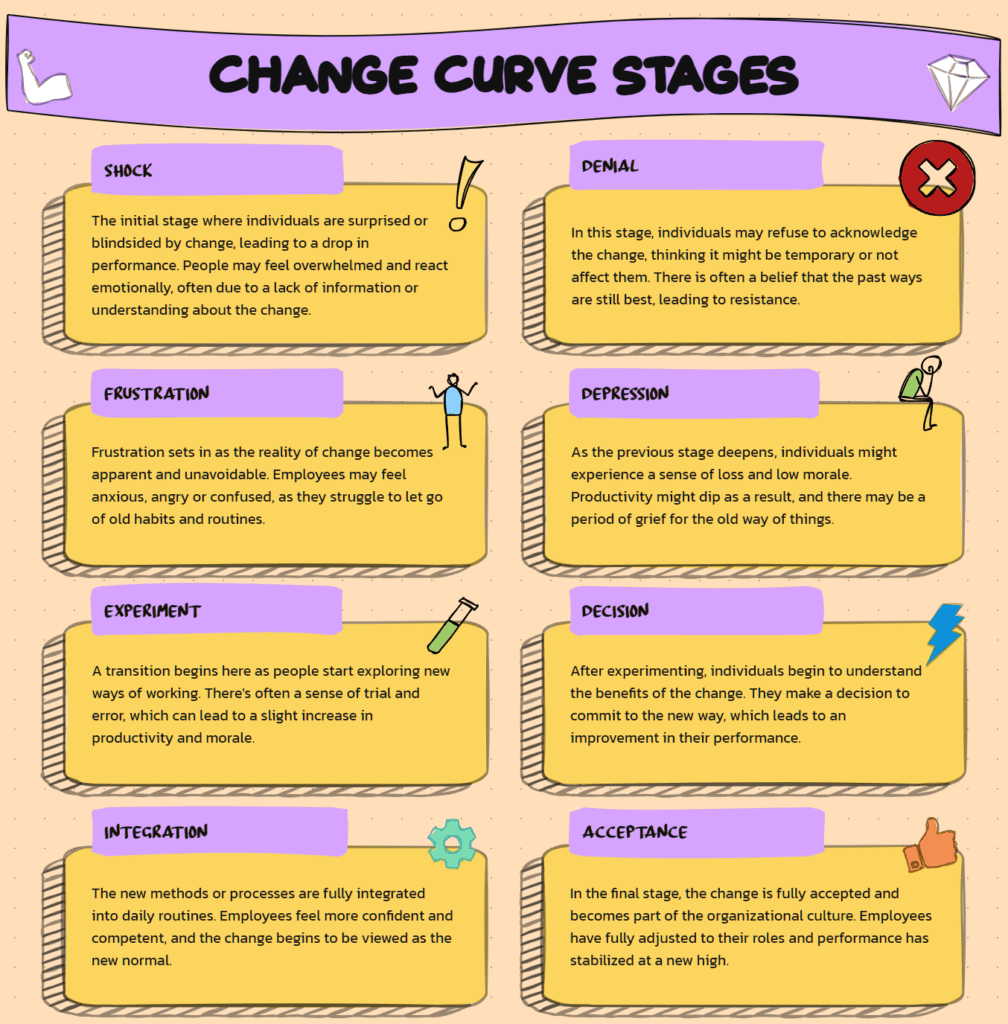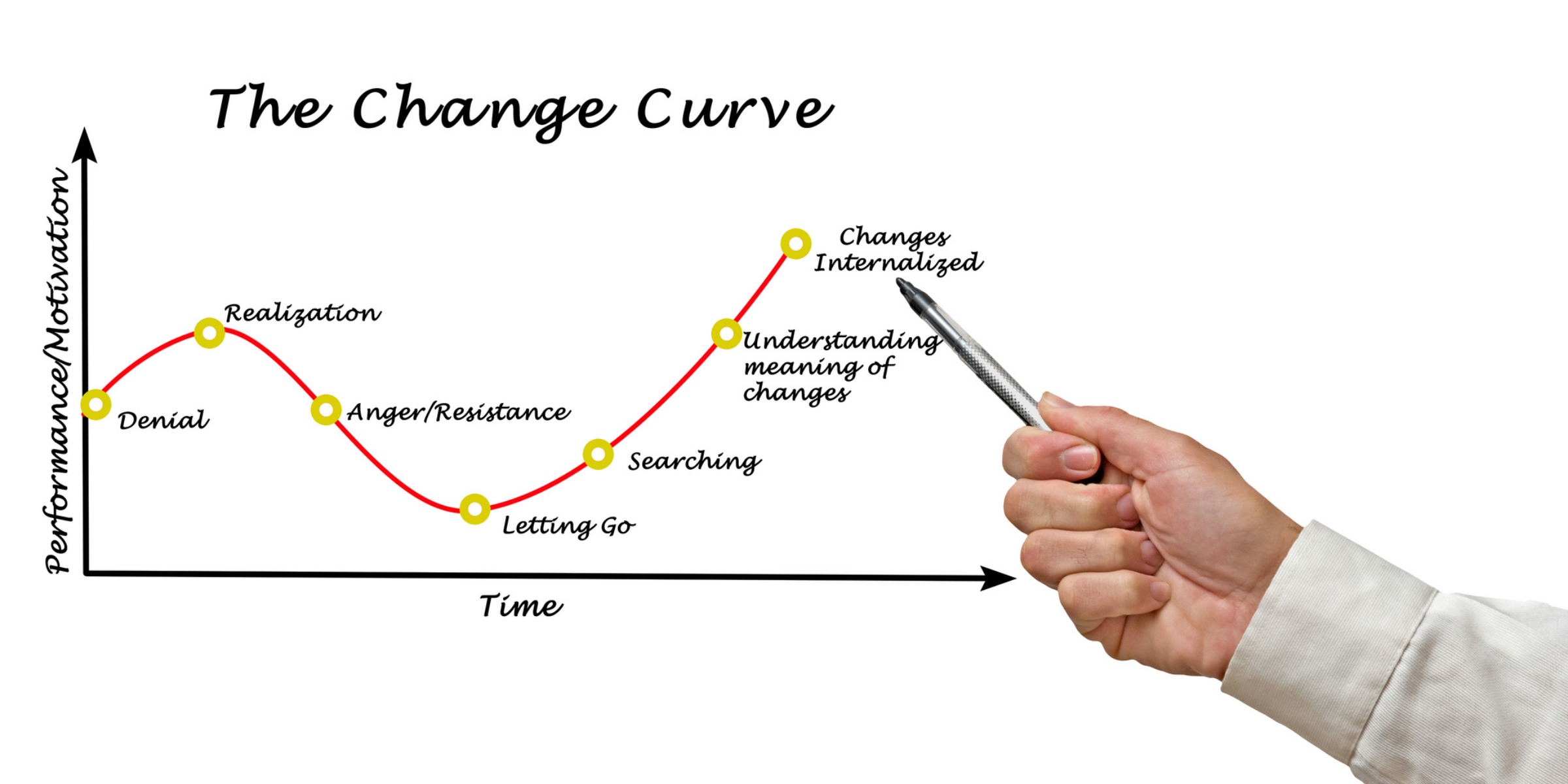You’ve heard the phrase ‘change is inevitable,’ and you know that it’s true. Whether it’s a shift in your personal life or a change in your workplace, you will experience change at some point.
But how do you navigate these changes? How do you manage the emotions and reactions that come with them? This is where the Change Curve Model comes in.
The Change Curve Model is a tool that helps you understand the emotional stages that people go through when faced with change. It can be applied to both personal and professional situations and can help you manage your own emotions as well as those of others.
In this guide, we will explore the eight stages of the Change Curve, how to manage each stage, and how to apply the model in different settings. With this knowledge, you will be better equipped to successfully navigate change and come out on the other side stronger and more resilient.
The Importance of Understanding the Change Curve Model
It’s crucial to grasp the significance of comprehending how people react to change and the emotional rollercoaster they experience along the way. Understanding resistance is a key component of this, as it can help you anticipate how people will react to change and how you can help them through the process.
Resistance to change is a natural human response, and it’s important to acknowledge and address it in order to facilitate successful transitions.
Emotional intelligence in change is also vital to understanding the change curve model. By recognizing and understanding our own emotions and those of others, we can better navigate the ups and downs of the change process.
Emotional intelligence allows us to empathize with others and offer support, and it can also help us manage our own emotions to prevent burnout or negative reactions.
In short, understanding the change curve model is crucial for anyone involved in managing or implementing change. By recognizing resistance and utilizing emotional intelligence, we can help people navigate the change process more effectively, resulting in smoother transitions and better outcomes.
The Eight Stages of the Change Curve
You’re about to learn the eight stages of the change curve, which will prepare you for any upheaval so you can handle it like a pro.

Broadly speaking these 8 stages fit into 3 main steps: The first is where you might feel shock, disbelief, or even numbness. It’s natural to resist change, especially if it wasn’t your idea. However, it’s crucial to recognize these feelings so you can move forward.
The second is where you might feel angry, frustrated, or overwhelmed. This is where managing resistance becomes important. It’s essential to acknowledge your emotions and communicate them effectively. By doing so, you can gain a sense of control and work towards finding solutions.
The final is where you start to see the potential benefits of the change. You might feel curious, hopeful, or even excited. However, this part of the process can also be challenging as it requires you to let go of old habits and ways of thinking.
Emotional reactions may include anxiety or uncertainty. It’s important to stay open-minded and flexible during this stage, as it can be a time of growth and learning.
How to Manage Each Stage of the Change Curve
As you navigate each stage of the change curve, managing your emotions and staying open to new possibilities can help you build resilience and adapt to the challenges ahead.
In the first stage of denial, it’s important to acknowledge your resistance to change and understand why you feel that way. This can help you move past denial and into the second stage of anger, where you may feel frustrated or upset. In this stage, it’s important to express your feelings in a constructive way and seek support from others.
As you move into the third stage of exploration, it’s essential to remain curious and open to new ideas. This stage is all about finding solutions and adapting to the changes around you. It’s important to seek out opportunities for growth and development, whether that means taking on new responsibilities or seeking out new perspectives.
In the fourth stage of commitment, it’s important to stay focused on your goals and remain committed to the changes you’ve made. Managing each stage of the change curve can be challenging, but with the right tools and mindset, it’s possible to build resilience and adapt to new situations.
By managing resistance, acknowledging your emotions, and staying open to new possibilities, you can successfully navigate each stage of the change curve and emerge stronger and more adaptable than ever before. Remember that change is a natural part of life, and with the right mindset and approach, you can thrive in the face of uncertainty.
Applying the Change Curve Model in Different Settings
Navigating through the different stages of the change curve can be compared to maneuvering a ship through rough waters, as each stage presents its own set of challenges and requires a different approach to successfully adapt to change in various settings.
Real-life examples of the change curve model being applied include businesses implementing new technology, individuals dealing with personal changes such as a job loss, and even entire communities adapting to a natural disaster. In each of these settings, understanding the change curve model can help individuals and organizations anticipate the different stages of change and develop strategies to manage them effectively.
However, it’s important to note that the change curve model has its limitations. For one, it assumes a linear progression through the different stages, but in reality, individuals and organizations may move back and forth between stages or even get stuck in one stage. Additionally, the model may not account for external factors that can influence the change process, such as cultural differences or societal norms.
Despite these limitations, the change curve model remains a valuable tool for navigating change in various settings.
To apply the change curve model effectively, it’s important to understand the unique challenges and opportunities presented by each stage of the curve. In the initial stage of denial, individuals and organizations may resist change and deny the need for it. This stage requires patience and understanding, as individuals may need time to process the change and its implications.
As individuals move through the different stages, it becomes increasingly important to communicate clearly and provide support. By adapting to the different stages of the change curve and developing strategies to manage them effectively, individuals and organizations can successfully navigate change and emerge stronger on the other side.
Tips and Strategies for Successfully Navigating Change
It’s crucial to have practical tips and effective strategies for thriving during times of transition. One of the most important skills to develop is emotional resilience.
Change can be difficult, but it’s important to stay positive and maintain a sense of perspective. When you encounter obstacles or setbacks, focus on what you can control and take small steps forward. Stay optimistic and recognize that setbacks are a normal part of the change process.
Another key strategy is to develop effective communication skills. During times of change, communication is vital to keeping everyone on the same page and minimizing misunderstandings. Be clear and concise when communicating your ideas and goals. Listen actively to others and seek out feedback.
It’s also important to be open and transparent about the changes that are happening and how they will impact everyone involved.
Finally, remember that change is a process, not an event. It takes time to adjust to new situations and find your footing. Be patient with yourself and others as you navigate through the change curve.
Celebrate small wins along the way and use them as motivation to keep moving forward. By developing emotional resilience and effective communication skills, you can successfully navigate change and come out stronger on the other side.
How Can the Change Curve Model Help with Navigating Digital Transformation?
The change curve model offers valuable navigating digital transformation tips. By understanding the stages of disbelief, resistance, exploration, and commitment, companies can effectively guide their teams through the process of digital transformation. Supporting employees through each stage can lead to a more successful and seamless transition.
Conclusion
Congratulations! You’ve just finished reading a comprehensive guide to understanding the Change Curve Model and how to use it. By now, you should have a clear understanding of the eight stages of the change curve and how to manage each stage successfully.
You’ve also learned how to apply this model in different settings and have gained valuable tips and strategies for navigating change.
Did you know that according to a survey conducted by McKinsey & Company, only 26% of organizational change initiatives are successful in achieving their goals? This statistic highlights the importance of using tools like the Change Curve Model to manage change effectively.
By understanding and applying this model, you can increase the chances of success and ensure that your organization is better equipped to handle change.
Remember, change can be challenging, but it can also be an opportunity for growth and development. By embracing the Change Curve Model, you can navigate through the various stages of change with confidence and emerge stronger on the other side.
So, go ahead and put your newfound knowledge into practice – you’ve got this!





